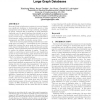302 search results - page 59 / 61 » A Multi-Agent Implementation of Social Networks |
EDBT
2009
ACM
14 years 8 days ago
2009
ACM
Structured data including sets, sequences, trees and graphs, pose significant challenges to fundamental aspects of data management such as efficient storage, indexing, and simila...
CORR
2010
Springer
13 years 6 months ago
2010
Springer
The neighbourhood function NG(t) of a graph G gives, for each t ∈ N, the number of pairs of nodes x, y such that y is reachable from x in less that t hops. The neighbourhood fun...
WWW
2011
ACM
13 years 2 months ago
2011
ACM
The clustering coefficient of a node in a social network is a fundamental measure that quantifies how tightly-knit the community is around the node. Its computation can be reduce...
HICSS
2010
IEEE
14 years 2 months ago
2010
IEEE
Communities of practice (COPs) have been around since the founding of the first social networks many millennia ago. Organizations around the world over the last two decades have l...
AGILEDC
2009
IEEE
14 years 2 months ago
2009
IEEE
—The Scrum software development framework was designed for the hyperproductive state where productivity increases by 5-10 times over waterfall teams and many colocated teams have...

